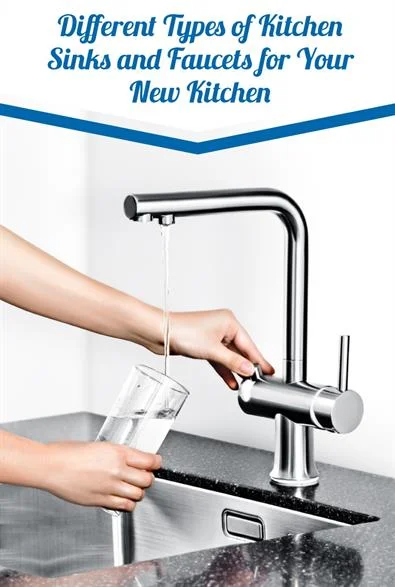
As the place where you prepare meals, connect with family, spend holidays, and start every morning with a warm cup of coffee, your kitchen is the heart of your home. Along with the laughter, good times, friendly faces, and fantastic flavors your kitchen sees, however, it also experiences its fair share of wear and tear. When your kitchen has been well-loved for many years, it might be time to think about renovating and remodeling to get the upgraded features, functionality, and aesthetics you desire in your dream kitchen.
Upgrading your kitchen lets you reimagine your space and craft it into the up-to-date, modern area or classic country space you've been hoping for. It also improves the room's use by letting you choose the specific features and fixtures that work best with your cooking, cleaning, and other kitchen habits. As an essential part of your kitchen — from rinsing vegetables and filling pots to cleaning dishes and washing your hands before you handle food — the type of kitchen sink you choose is key to the quality of your kitchen remodel.
If you're not sure what to pick between the different types of kitchen sinks, materials, types of faucets and handles, and other considerations, don't worry. From choosing kitchen sink styles to finding the best kitchen faucets and other kitchen remodeling concerns, we're here to help you turn your kitchen into the perfect setting for many more years of laughter, meals, and memories.
Choosing Between the Different Kitchen Sink Styles
When it comes to the different types of kitchen sinks and figuring out which works best for your kitchen setting and needs, there are a lot of factors to consider — from kitchen sink styles to the materials you want your sink to be made of. When you're considering the pros and cons of different sink types, here's what you need to know about each option:
Single-Bowl Sink: Designed for smaller kitchens with less counter space, single-bowl sinks are composed of one big basin sunk into the counter. While single-bowl sinks aren't good for multitasking — like cooking, prep and cleaning simultaneously — they're great for piling and cleaning they're great for piling and cleaning dishes without worrying about making a mess on your counter, and they're relatively easy and less costly to install.

- Double-Bowl Sink: Also described as a divided sink, the double-bowl sink is similar to the single-bowl but designed with a divider to split the basin into two sinks with separate drains, making it easy to multitask cooking, cleaning, and prep or use one side for drying clean dishes on a dish rack. This design is better for multi-member households that also want to keep things relatively simple. Like their single-bowl counterparts, double-bowl sinks are typically easy and relatively inexpensive to install.
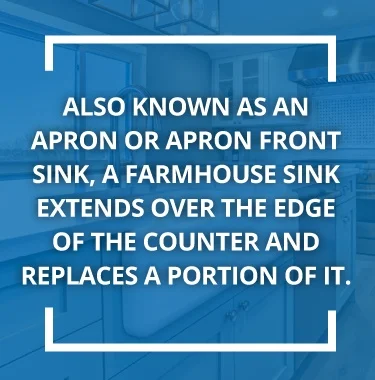 Farmhouse Sink: Also known as an apron or apron front sink, a farmhouse sink extends over the edge of the counter and replaces a portion of it. Popular with people seeking rustic, traditional, or farmhouse-style interior designs for their kitchens, these sinks have large, deep basins good for large families and a good deal of dishes and cleanup. While they typically come in cast-iron or fireclay, some models can be designed in stainless steel or composites for a more modern look. While farmhouse sinks are extremely durable and easy to clean, they are also costly and more difficult to install because of the extra work it takes to cut out a portion of your counter.
Farmhouse Sink: Also known as an apron or apron front sink, a farmhouse sink extends over the edge of the counter and replaces a portion of it. Popular with people seeking rustic, traditional, or farmhouse-style interior designs for their kitchens, these sinks have large, deep basins good for large families and a good deal of dishes and cleanup. While they typically come in cast-iron or fireclay, some models can be designed in stainless steel or composites for a more modern look. While farmhouse sinks are extremely durable and easy to clean, they are also costly and more difficult to install because of the extra work it takes to cut out a portion of your counter.- Undermount Sink: Installed and mounted directly beneath the counter, under-mount sinks have no rim or sink edge but drop straight from counter to sink basin, providing a clean, seamless look perfect for a modern interior. Because of their sleek nature, under-mount sinks work with almost any kind of kitchen layout. In addition to their versatile appearance, these sinks also make for an easy cleanup process because you can just sweep food particles and crumbs straight from counter to sink without anything getting caught or encrusted on a rim. Because the sink needs to be glued to the bottom of the counter, this type can take more work and be more costly to install while also possibly needing an internal support system, depending on the heaviness of the material used. Also, most undermount sinks aren't designed with holes for faucets, so you'll need to have these additions cut into your counter and installed separately.
- Bar Sink: Intended to be installed in a home wet bar setting or as a secondary sink option, bar sinks are smaller and less deep than typical sink basins. With a small, single-bowl design, bar sinks are ideal for cooking prep, drink preparation and a convenient cleanup process. Add this sink option in addition to your regular sink if you have a home bar or often entertain.
- Corner Sink: A double-bowl sink design positioned in the corner of the counter where two walls meet, corner sinks involve two sink basins catty-cornered with a faucet in the corner between. This unique design can maximize your counter space and add to almost any kind of kitchen look, but custom cuts can make the installation more costly and time-consuming.
- Top Mount Sink: Also known as drop-in sinks, top-mount kitchen sinks drop into the counter with a rim or lip formed around the top on the counter's surface, holding the sink in place and contributing to a more finished appearance. This sink's lip provides support, meaning no internal support system is required and you can choose almost any material you desire. Top mount sinks are also relatively inexpensive and easy to install.
In addition to the composition style of your sink, you have a variety of sink materials to choose from. Depending on where your sink is located, what uses you have planned for it, how well you want it to wear and what your aesthetic preferences are, each material has its pros and cons. Here are the most common materials you have to pick from:
- Fireclay: Composed by molding ceramic clay into a sink shape and letting it dry at a high temperature for up to 40 hours, then coated in porcelain enamel and fired in a kiln at very high temperatures for more than 20 hours, fireclay sinks are strong and resistant to both stains and dirt or grime accumulation — They're also easy to clean with any material. The porcelain-like nature of fireclay does make it susceptible to chipping or cracking from dropped dishes or pots. Fireclay can come in black, biscuit or white and is entirely solid in color. Farmhouse sinks are the style most commonly constructed from fireclay.
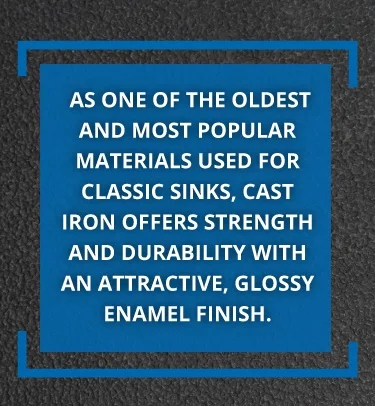 Cast Iron: Cast iron offers strength and durability with an attractive, glossy enamel finish. Made by casting iron and coating it in porcelain enamel melted on to prevent rusting, this sink material is incredibly resistant to stains and scratches, especially heavy and durable, and resistant to wear from lighting and fading. It is also easy to clean. Because it's so heavy, cast iron can be difficult and more costly to install, and if the ceramic finish does chip to reveal the iron, it will begin to rust relatively quickly. Cast iron sinks are available in a wide variety of colors and styles.
Cast Iron: Cast iron offers strength and durability with an attractive, glossy enamel finish. Made by casting iron and coating it in porcelain enamel melted on to prevent rusting, this sink material is incredibly resistant to stains and scratches, especially heavy and durable, and resistant to wear from lighting and fading. It is also easy to clean. Because it's so heavy, cast iron can be difficult and more costly to install, and if the ceramic finish does chip to reveal the iron, it will begin to rust relatively quickly. Cast iron sinks are available in a wide variety of colors and styles.- Granite Composite:Made from a combination of materials, granite composite sinks are composed of crushed granite and a resin filler. This process forms a sink material with the characteristics and appearance of granite but without the same durability or maintenance issues. Incredibly durable and long-lasting granite composite sinks are hardy and highly resistant to scratching and stains.
- Quartz Composite:Like granite, quartz can be difficult to maintain as a material on its own, so quartz-based sinks are usually made of a quartz composite — or a combination of crushed quartz and an acrylic resin filler. The resulting non-porous, sturdy surface offers durability, bacteria resistance and stain resistance in a variety of styles and colors to match your kitchen. Quartz composite sinks are also simple to clean, quiet during use and resistant to stains, scratches and chips.
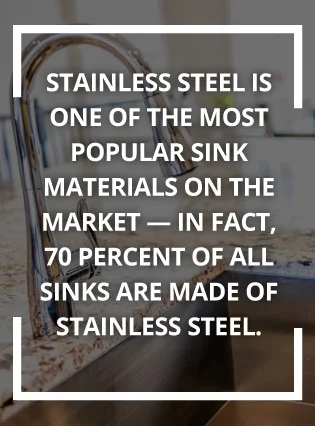 Stainless Steel:Unlike some other materials, stainless steel is inexpensive and easy to come by, and it is also versatile enough to work for almost any kitchen sink style. Light and easy to install, stainless steel is classified by gauge or sheeting thickness. Thicker sinks will be heavier and more costly, while thinner gauges make less expensive options. While stainless steel can dent and make more noise than other sink materials, it is also incredibly durable, heat-resistant and stain-resistant, and they make a good aesthetic addition to any modern kitchen.
Stainless Steel:Unlike some other materials, stainless steel is inexpensive and easy to come by, and it is also versatile enough to work for almost any kitchen sink style. Light and easy to install, stainless steel is classified by gauge or sheeting thickness. Thicker sinks will be heavier and more costly, while thinner gauges make less expensive options. While stainless steel can dent and make more noise than other sink materials, it is also incredibly durable, heat-resistant and stain-resistant, and they make a good aesthetic addition to any modern kitchen.- Metal: In addition to the classic stainless steel option, sinks can also come in a variety of other metals. Like stainless steel, metal sinks can be susceptible to denting and some scratching as well as making more noise when you wash dishes, but they're also durable and built to be resistant to rust and corrosion. In addition, unusual materials like copper or brushed nickel offer a unique look to complete your kitchen aesthetic.
Choosing the Best Kitchen Faucets and Other Sink Fixtures
Choosing a new kitchen sink doesn't just mean picking the style and material of the sink itself — you also have to think about the different types of water faucets and handles to make your sink complete. Here are popular types of kitchen sink faucet styles and fixtures you could choose for your property:
Single-Hole Faucet: Single-hole faucets are known for their simplicity and are named for the fact that they require only one hole in the countertop to be properly installed. With a top-mounted handle to control pressure and temperature and a single spout for water, a single-hole faucet typically has a curved neck to minimize the amount of splashing in your sink. While its design is simple, this faucet can be customized and adjusted with different types of aerators and flow-control buttons. These faucets are easy to use and easy to find wherever faucets are sold.

- Centerset Faucet:Also called two-hole or two-handle faucets, centerset faucets have two different handles to control the hot and cold water that will emit from the single spout in the center — the handles and the spout are all connected to a metal plate that sits in the center of the sink rim. Because centerset faucets have two different lines for hot and cold water, they'll require multiple holes for installation. This option is popular among families who want to make sure their kids can't make the water too hot, and they can offer a more elaborate design in terms of aesthetics.
- Widespread Faucet: Almost identical to centerset faucets with two separate handles for hot and cold along with a single spout in the center, widespread faucets differ only in their lack of a metal plate to connect the faucet components. Instead, the individual pieces are installed separately and spaced anywhere from a few inches to over a foot apart. This lets you customize your sink layout and design more specifically to your needs — which is especially helpful if you need to install extra accessories like soap dispensers and side sprayers — but it will also require multiple holes to be installed in your countertop.
 Pull-Out Faucet: As their name suggests, pull-out faucets are water spouts with a detachable head you can use to pull closer to you or spray more pointedly. The detached head is attached to a hose or snake that extends from the faucet fixture, offering you a wide range of flexibility. These pull-out faucets can cause more splashing in your sink, but they're great for cleaning, rinsing and washing dishes — and they also come in a wide variety of materials and styles to match your kitchen.
Pull-Out Faucet: As their name suggests, pull-out faucets are water spouts with a detachable head you can use to pull closer to you or spray more pointedly. The detached head is attached to a hose or snake that extends from the faucet fixture, offering you a wide range of flexibility. These pull-out faucets can cause more splashing in your sink, but they're great for cleaning, rinsing and washing dishes — and they also come in a wide variety of materials and styles to match your kitchen.- Pull-Down Faucet: Similar to the pull-out faucet in function but different in design, pull-down faucets are built fixed in a downward spout position with heads that extend further down to an extent to offer you a little more flexibility and a direct water stream for spraying dishes and cleaning up. While they don't offer quite as much freedom as pull-out faucets and can be a bit more difficult to use in small spaces, pull-down faucets also cause less splashing and make it easier to remove difficult spots on pots and pans.
- Side Sprayer Faucet: As an alternative to the possible mess of the pull-out faucet, the side sprayer faucet is designed as an additional spray option positioned next to the regular faucet on your sink rim. While it will use the same pipes and extend like a detachable sprayer, it will also offer its own features when it comes to power, swivel capabilities and adjustable spray. This faucet option can extend far, clean well and is available in a variety of customizable options, although it can still cause some significant splash.
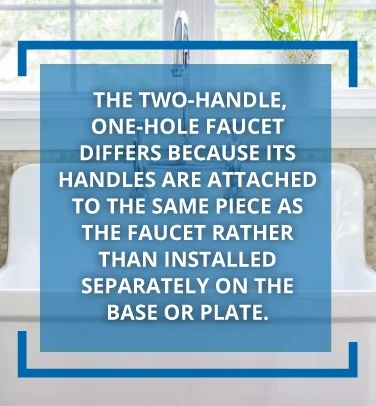 Two-Handle, One-Hole Faucet: With separate control handles for hot and cold water — similar to the centerset faucet — the two-handle, one-hole faucet differs because its handles are attached to the same piece as the faucet rather than installed separately on the base or plate. This faucet only requires one hole in your counter and is easy to install, but its only drawback is the fact that the entire piece will need to be replaced if a single part stops working.
Two-Handle, One-Hole Faucet: With separate control handles for hot and cold water — similar to the centerset faucet — the two-handle, one-hole faucet differs because its handles are attached to the same piece as the faucet rather than installed separately on the base or plate. This faucet only requires one hole in your counter and is easy to install, but its only drawback is the fact that the entire piece will need to be replaced if a single part stops working.- Basin Tap Faucet: Offering you an alternative way to control hot and cold water in your sink, basin tap faucets are composed of two mini faucets positioned side by side. Instead of letting you choose what temperature of water flows through your central spout, basin tap faucets are separated into two different spout units — one for each temperature. This kitchen faucet style is available in various styles and materials and is easy to control, but with no larger, central spout, sometimes it can make bigger washing endeavors more difficult.
- Wall Mounted Faucet: Installed in the wall above the sink rather than on the sink itself, wall-mounted faucets are great for small kitchens with limited sink or countertop space. Available in a variety of sizes, styles, colors and flow options, these faucets are customizable to your tastes and are easy to maintain. Be careful where you point your spout, however, or you might end up with an extra splash.
- Pot Filler Faucet: Originally designed for restaurants and commercial uses, pot filler faucets are usually attached to the wall and have thin, long spouts designed to fill high-volume pots or deep basins. If you're a seasoned cook or your kitchen sees a lot of fast-paced use, this faucet might be great for your home. Be cautious before installing a pot filler faucet, however — they're made for high-pressure, high-volume action that might not work with your water line.
- Cold Water Dispenser Faucet: If you work mostly with fresh fruits and vegetables or meats to rinse, live in a hot climate where readily-available cold water is of the essence or see no need to use hot water for your kitchen sink, you have the option of choosing a faucet that dispenses only cold water in an easy-to-use design for your basic uses.
- Hot Water Dispenser Faucet: Just like you can install a faucet that only offers cold water if you want to save time on washing stubborn dishes, filling steaming cups for coffee or tea in the morning or other warm-water uses, you can invest in a basic, easy-to-install hot water dispenser that lets you access instantly heated water without the wait.
- Faucets With Water Filters: If you want to source your drinking water straight from the tap but you're worried about toxins that might make their way through the water line, a faucet with a pre-installed filter might be the perfect fit for you. Providing fresh, tasty water and removing any toxins from the tap, faucets with water filters come in a variety of styles to match your kitchen and tastes, although they tend to be on the expensive side.
- Commercial Kitchen Faucet: If you won't settle for anything less than the best in your kitchen, a commercial kitchen faucet will offer you the sleek, advanced, professional-grade design and performance you seek. Available in a variety of styles and sizes — usually bigger and better than traditional household faucets — commercial kitchen faucets offer advanced technology and impeccable style to handle high-volume or high-class kitchen needs. You can expect this kitchen faucet style to cost more than your average home faucet.
4 Primary Types of Faucets
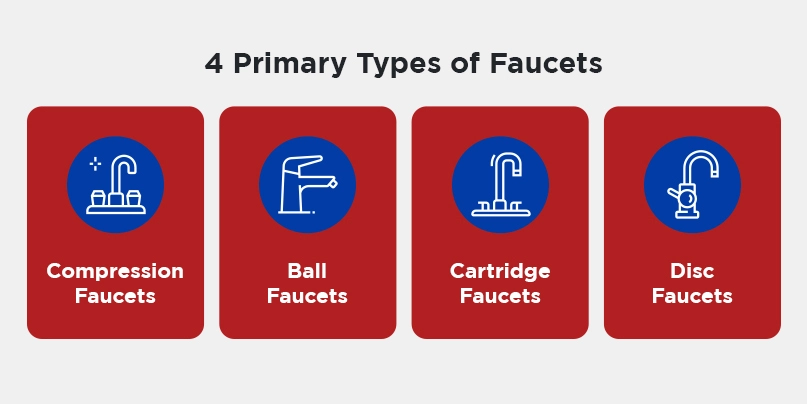
While the list of kitchen sink faucet designs is expansive, they all fall into four general functional categories of sink faucet types. Knowing what kind of faucet you currently have or want will help you decide whether to find similar styles or look for new ones while remodeling your kitchen. The most common different types of faucets include:
Compression Faucets
Compression faucets are one of the oldest types of faucets. They have separate handles that control whether the water is hot or cold. Most models require you to loosen and tighten the handles, like turning on the water for a garden hose, to turn the water on and off. Compression faucets provide water flow by using a compression stem, a type of screw with a rubber washer at its end acting as a seal to stop the water once it is off.
Ball Faucets
Ball faucets have one handle that sits on a ball-shaped cap above the spout. Turning the water on involves lifting the handle and positioning it left or right to control the temperature. The ball part of the faucet acts as a chamber filled with rubber seals and O-rings that make the faucet work.
Cartridge Faucets
A cartridge faucet is similar to a compression one, but you do not have to make sure the handles are fully tight when turning the water off. A simple half-turn is all that's needed to turn the water on and off. Cartridge faucets have a smooth, easy and consistent feel.
Disc Faucets
A disc faucet is the newest type of faucet technology. It uses a single lever attached to a cylindrical body to turn the water on and off. In the body is a pressure balance cartridge with two ceramic discs toward the bottom. When you turn the faucet on, hot and cold water enters the chamber and mixes. The temperature you get depends on the position of the lever. Once you decide what temperature you want, the discs at the bottom open and close to control the water flow.
Tips for Remodeling Your Kitchen
Ready for your kitchen remodel? Make sure to review these tips before getting started:
1. Consider Your Needs
When it comes to reimagining and redesigning your kitchen, the most important part of making your new space perfect for your home and your family is constructing an environment that fulfills your needs and matches your lifestyle. When you make your remodel decisions, think about your cooking and cleaning habits and needs and choose the best kitchen sinks, faucets and other attributes to suit your kitchen style.

2. Consider Your Space
Your kitchen remodel choices should also depend on what you already have to work with. When making a plan and choosing new appliances and features like your kitchen sink, it is important to consider your counter space, moving room, what areas of the kitchen will be used for what tasks, and what placement of features will be most conducive to maximizing your space for comfort and functionality. You should also choose features that fit with your aesthetic style or vision for your new kitchen.
3. Stick To Your Budget
While you might want the best of everything for your newly remodeled kitchen — and while quality is certainly important when considering kitchen sink styles, kitchen faucets, and other features — it is important to stay true to your budget and make high-quality choices that are also economical.
4. Consult a Professional
Whether you're working with a home designer or conducting your kitchen remodeling mostly on your own with a DIY spirit, it is important to make sure your new kitchen faucet and sink are installed properly so they work seamlessly with your plumbing system. Ensure your kitchen is properly equipped for your new sink and faucet and everything is in working order by hiring a professional, licensed plumber to do any necessary plumbing work.
Trust Mr. Rooter of Greater Syracuse for all Your Kitchen Plumbing Needs
If you're looking for a reliable, exceptional plumbing company to meet all your needs for your new kitchen and make sure your sink and faucet work fantastically, there is no better place to turn than Mr. Rooter Plumbing of Greater Syracuse. With a philosophy founded on service, trust, integrity and a strong customer focus, we have been providing high-quality plumbing service and care to our customers for almost 50 years.

Offering every residential plumbing service you could ask for — from clogged drain assistance and drain cleaning services to plumbing repairs and inspection, water line repairs, water line installation and so much more — we make it our business to perfect your plumbing with a passion. You can even have a service professional come out and perform a No Charge Plumbing Check-Up. Trust us to complete your new kitchen with care! Call us or contact us online today for all your plumbing service needs.

